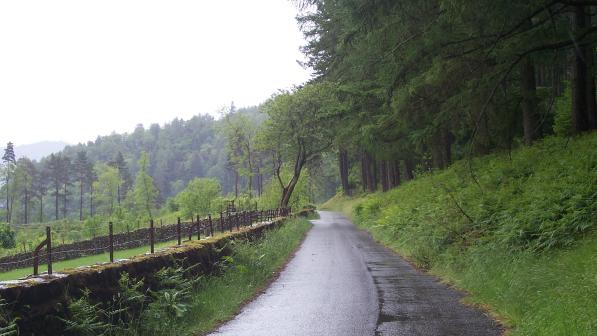Object to proposed cycling ban on Lake District road

National Cycle Network route 6 passes along the western shore of Thirlmere reservoir. This lane along the lakeshore is not only stunningly beautiful, but also one of the only safe road cycling routes leading towards Keswick.
The alternative route up the eastern shore, along the A591, is along a narrow section of busy A-road, hemmed in by walls with fast traffic and HGVs.
However, the quiet western road has been temporarily closed for two years following Storm Arwen. Now, there’s a risk it might not reopen at all.
Cumberland Council has proposed a Traffic Regulation Order (TRO) to permanently close part of the road to all traffic – including cyclists and walkers. This would leave two dead-end roads with no through route and no safe alternative.
The consultation is only open until 22 September 2023 – please join us in objecting to the closure before we lose the use of this route completely.
Why is the road closed?
In 2018, the ‘Beast from the East’ (Anticyclone Harmut) teamed up with Storm Emma to batter the north-west of England with wind and heavy snow for two weeks. The storms uprooted several large trees along the length of Thirlmere reservoir, and the road was closed for several months while contractors worked to repair the damage.
In November 2021, Storm Arwen destroyed 1500 more trees, resulting in another temporary road closure due to fallen trees and disturbed rocks on the crags above.
The road has remained closed ever since, with no safe diversion route for walkers and cyclists.
Temporary closures usually have a maximum time limit of 18 months, with some exceptions. A freedom of information request to the council revealed that they still do not have any predicted date for repair and reopening of the route, and a recent letter to local residents states that “Further assessments are scheduled to gather more information relating to the condition of the hazardous area”.

The safety question
A council press release comments that “detailed evaluations by United Utilities assessed damage across Rough Crag, including hidden sections, such as tree damage and loose rock hazards. Ongoing discussions are taking place with United Utilities to determine if technical solutions can make the road safe again”.
If these investigations and discussion are still ongoing, the decision to permanently close the road seems presumptuous.
What progress has been made in investigating and exploring alternative options over the two years that this route has already been ‘temporarily’ closed?
Public safety is important, and falling rocks are an obvious hazard. However, there are plenty of roads around the country where falling rocks remain a risk without resulting the extreme solution of permanent closure. There are a variety of mitigating steps in different places, such as fencing or netting - in fact, netting is already used to prevent rock falls on the A591 on the opposite shore. So why haven't these solutions been considered to reopen the route here? Instead, the council is opting to close one of the most enjoyable and atmospheric cycling routes in the Lake District.
Crucially, any risk assessment seems to have been focused solely on the risk of falling rocks on this road, without looking at the bigger picture of cycle safety.
Closing this route forces cyclists onto a busy, and arguably much less safe, A-road up the eastern bank of the reservoir. A freedom of information request seeking copies of the risk assessment for the closure and diversion route was responded to with the comment: “The diversion route only stipulates suitability for vehicular traffic; therefore no diversion route is provided for pedestrians and cyclists at this time. This is under re-assessment as the extent of the work required is established with United Utilities”.
Aside from the fact that cycles are classed as vehicles in highways law, we think that approach seems ridiculous. Any assessment of the benefits and risks of closure on the grounds of safety clearly needs to look at the bigger picture and what is likely to result from this route being closed, not just the risk of keeping it open.

Who is responsible?
Historically, the responsibility for maintaining the road falls to United Utilities, the UK’s largest water company.
The road in its current form was created as part of the development of Thirlmere reservoir, under the Manchester Corporation Waterworks Act of 1879. This stated that “The new roads constructed under the authority of this act shall be public roads, but shall be maintained by and at the cost of the Corporation for ever…”
The successor to the Manchester Corporation is United Utilities, who seem unwilling to fulfil their legal duty to maintain the road.
The problem is, the people who lose out as a result of this closure will not be United Utilities or their shareholders – it will be the wider public who are denied the right to walk, cycle and horse-ride along this quiet and scenic road in the heart of the Lake District.
Why is Cycling UK getting involved?
Thousands of traffic regulation orders are issued every month. Why is this one worth making a fuss about?
We think it’s more than just a local issue: it has a much wider impact.
The closure shifts cyclists, horse riders and walkers from a safe, quiet road, to a busy, unsafe A-road, without any comparative safety audit. That disregards the Traffic Regulation Act criteria for making an order, and is a flawed decision-making process.
This section of National Cycle Network route 6 is important for local people living around Keswick, and it’s also a popular area for people visiting from further afield, so has wider relevance. Perhaps you have even had the pleasure of cycling it yourself at some point.
It is also significant that this is within a National Park. All public bodies and utility companies have a statutory duty to have regard to National Park purposes: namely to conserve and enhance their natural beauty, wildlife and cultural heritage, and to promote opportunities for the understanding and enjoyment of their special qualities by the public. Closing this road goes against those duties, which is why we think it’s important to resist it.
A petition against the road closure has gathered over eight thousand signatures in just a few weeks - but petition signatures won't carry the same weight as formal objections to the order.
What you can do
Please email Cumberland Council today and object to this order before the consultation closes on 22 September.
We’ve made it as quick and simple as possible by providing a template objection below which you can copy, or you can also download it as a word document.
So we can keep track of submissions, please BCC or forward a copy of your objection to [email protected]
From:
Bcc: [email protected]
Subject: Traffic Regulation Order - Keswick and surrounding area consolidation order 2023, FORMAL OBJECTION
Dear Cumberland Council
I wish to object to the following sections of the above proposed order:
Reference: KTRO/23/PNG
Paragraph 44A & Schedule 33A - Prohibition of all Traffic, U7003 Thirlmere Western Road.
I believe that the proposed closure is unnecessary and premature for the following reasons:
- The authority has failed to fully consider the wider safety issues of risk created by closing the route and forcing cyclists on to the busy A591 instead. Any risk analysis needs to look at the total picture of risk and how it affects users, not just potential risks from falling trees and rocks.
- The authority has recently stated that “Further assessments are scheduled to gather more information relating to the condition of the hazardous area”. As a result, the use of a permanent closure is premature.
- The authority has failed to fully explore alternative solutions, including the use of netting or fencing (measures already in use on the A591 on the opposite side of the lake) in order to protect highway users from potential risk via falling rocks.
- The authority has failed to demonstrate that permanent closure is the only realistic option available.
- Both the authority and the landowner (United Utilities) have failed to have regard to National Park purposes in accordance with Section 62 of the Environment act 1995.
- The closure conflicts with the legal duties of United Utilities to maintain the route under Section 68 of the Manchester Corporation Waterworks Act 1879.
- The closure would remove a key safe route without delivering any form of practical, safe alternative route for vulnerable road users.
As a result, the decision to close this route is unacceptable, and fails to fulfil the authority’s legal duty to secure the expeditious movement of traffic on the authority's road network. The authority should instead redouble its efforts to secure the reopening of this important route in order to allow vulnerable road users to fully enjoy the National Park.
Yours faithfully






